Legacy of KainSoul Reaver 2 Feature Preview
Eidos recently allowed us an exclusive first-hand look at Soul Reaver 2. We present you with all the pertinent information.
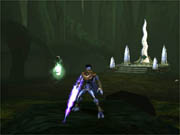
The original Soul Reaver's ending left no doubt in anyone's mind that a sequel was forthcoming. Indeed, the game was a mere fraction of the grand tale envisioned by its developer. Consequently, Eidos and Crystal Dynamics were quick to announce the game's sequel--a game that would tie up the loose ends presented by the original and weave a twisted tale all its own. That game is nearly upon us.
"... we think that everyone who's anticipating Soul Reaver 2 will be very happy that they waited."- Andrew Bennet, Executive Producer on Soul Reaver 2
Eidos Interactive recently brought a playable version of Soul Reaver 2 to our offices and allowed us to take a deep look at the game's progress. The build we got to examine had nearly all the game's elements in place, and it allowed us to truly appreciate both the game's thick, intense mood and its rich gameplay. Even at this point, it's easy to see that Soul Reaver 2 is a definite evolution for the series in every conceivable way. From a technical standpoint, the game is obviously much more sophisticated than its predecessor--the move to a much more powerful platform has enabled the team to realize many of the things impossible on the PlayStation and Dreamcast, due to time constraints, technical limitations, or a mixture of the two. The difference is plain to see--Soul Reaver 2's environments are grand, daunting, and meticulously detailed; its puzzles are significantly wider in scope and much more inspired than its predecessors; and its gameplay mechanics are deeper, more robust, and infinitely more engaging.
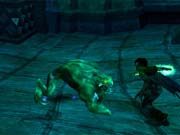
Crystal Dynamics has definitely taken a good, long look at the design of the original and strengthened many of its weaker points. "The power of a next-generation console such as the PS2 gives us the ability to make numerous incremental gameplay changes," Andrew Bennet, Soul Reaver 2's executive producer, explained in an interview about the game. "The 'lock and key' puzzle system is going to make Soul Reaver 2's puzzles much more engaging than those in Soul Reaver. Secondly, the ability to have more enemies--both in number and variety--in a particular area will make combat much more interesting. And lastly, the entire game now runs at a constant 60fps, making the gameplay feel much smoother and more fluid."
Bennet may be understating the overall effect of these enhancements by solely alluding to their technical properties, however--when seen in motion, all these factors create a loaded atmosphere that breathes a dreary, unreal life into the game's grand environments and perfectly sets the tone for its dark, surreal tale and rich, fluid gameplay. Gamers have long been yearning for an extension to the twisted dream presented by the Legacy of Kain series. The wait has been long indeed, but Bennet assured us that his team will make it worth the while in many ways: "Story-based action-adventure games are in many ways the most difficult to make, and that's why they take so long, but we think that everyone who's anticipating Soul Reaver 2 will be very happy that they waited."
Nosgothian Dreams
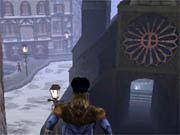
While it perhaps wasn't the team's initial intention, the original Soul Reaver's ending was quite a cliffhanger. After a climatic battle, Raziel chases Kain through a Chronoplast--a temporal portal--and emerges in a seemingly unknown realm. There, he meets Moebius, a character from Blood Omen, who Bennet described as "...a devious character, an ancient human sorcerer who has the ability to manipulate time." From Moebius, players learn that Kain discovered his devised means of time travel long ago and has intentionally lured Raziel into Nosgoth's past in order to realize his own mysterious ambitions. The story takes the requisite twists and turns and ends up spanning a good deal of Nosgothian history and toying with the ideas of time and reality. "Initially, Raziel naively believes that history is fragile and may be altered easily," Bennet explained. "He gradually comes to understand, however, that there's a 'conservation of reality' at work, and that history is essentially immutable--that it requires a kind of 'temporal wildcard' to change its course. Raziel ultimately realizes that his comprehension of Nosgoth's multilayered, twisted past is much more limited than he initially believed. He also discovers that he continues to be manipulated by others who understand Nosgoth's history--and the nature of time--better than he does."

Players faithful to the series will find many treats in store for them, in the form of allusions to past installments. As he travels through periods both peaceful and tragic, Raziel will be exposed to the people who influenced the history of Nosgoth, and he'll witness the events that continue to shape the land. All throughout, however, there will be a set of constants. "Throughout his journey, Raziel encounters characters and explores locations that will be familiar to fans of Blood Omen and Soul Reaver," Bennet continued. "The pillars, of course, are the geographical and spiritual hub of the entire game, and they are present (albeit changed) in all the time periods Raziel visits. We're sure that fans of the series will really enjoy the exploration of and allusions to key events in Nosgoth's past."
Those who played through Blood Omen--the first game in the series--will be familiar with its unique ending. At its conclusion, Kain--then a relatively young vampire--was forced to make a choice: either sacrifice himself for the sake of mortal balance or preserve himself and rule a wasted, hellish Nosgoth. For the sake of a grim narrative, Crystal Dynamics supposed that Kain chose the latter path when designing the future installments. As the first Soul Reaver made evident, the Nosgoth that Kain ruled was indeed an altogether grim place--vampires, twisted in form and soul, ruled over mortals, who they both domesticated and hunted for the purposes of satisfying their infernal hunger. The landscape of the world was blasted and razed, and humankind was but a shade of its former self. Soul Reaver 2, though, will give players a look at the world of Nosgoth before its inevitable descent as it ties the narratives of all three games into a tale than spans time. "Our goal with Soul Reaver 2 is to give the player the feeling of being swept up in historical events," Bennet revealed. "As the story unfolds, we present the player with revelatory moments when story elements from all three Legacy of Kain games suddenly come together. We look forward to seeing how fans react to these."
A Reaper of Souls
Of course, at the forefront of this twisted tale is Raziel--the reaper of souls, a cursed soul twice undead. This wasn't always the case, however. He was once a "perfect and noble vampire lieutenant who was cast into the Abyss by Kain in the opening cinematic of the game," as Bennet put it. Because of his vampiric heritage, though, the waters of the Abyss mangled his form and nearly brought him to his end. But due to the intervention of the mysterious Elder God, Raziel was resurrected and granted a host of supernatural abilities. The waters of the Abyss did grossly deteriorate his body, though, making him quite a horror to behold. He did look cool, despite this, and the humble 500 polygons used to model his form in-game were put to very good use.
|
It should come as no surprise that Soul Reaver 2 will give Raziel a significant face-lift. First, his poly count will increase dramatically-- roughly 3,000 have been used to model his onscreen persona in Soul Reaver 2. This results in a more robust and solid-looking character whose appearance, according to Bennet, is "a lot closer to the Raziel that we've previously only seen in high-resolution marketing images." A host of graphical niceties designed to truly set Raziel in his world have also been implemented. Inverse kinematics has been applied to his skeletal structure, resulting in more realistic movement and animation. Our time spent playing the game illustrated this rather well. On many occasions, we had to walk upstairs, but rather than superficially scaling the inclines, Raziel would actually take every step with a pronounced and realistic animation. And if we stopped between steps, Raziel would convincingly rest with a leg on each step, with both his knees realistically bent. The effect, however subtle, is quite impressive, and it does much to meld the character with the environments. Raziel's wings reacted realistically to wind sources, drifting and swaying as appropriate. Raziel's model will also be dynamically lit in the final game. Though this feature hadn't been implemented into the build we played, the effect should be quite impressive, once in place--lights and shadows will dance on his surfaces, as the environments dictate.
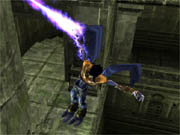
The powers that Raziel had at the end of the original Soul Reaver will still be available to him at the beginning of the sequel. The optional glyphs that players could collect will be gone, though. In their place, Raziel will have access to a slew of new abilities, all centered on the powerful Soul Reaver. "Over the course of the game, Raziel explores the mystery surrounding the Reaver's origin and expands the Reaver's mechanics by discovering and solving a series of ancient elemental forges attuned to the Reaver's power. This quest plays a major role in the storyline," Bennet explained. "After solving each of the forges, Raziel is able to imbue the Reaver with a new elemental power. Each type of reaver enables a new set of mechanics which Raziel will need to progress." The reavers will have a host of abilities, inside and outside of combat, and most will be elemental in nature--there will be fire, water, earth, and air reavers, for example. While the combat abilities of these are implicit, we can assume that they'll have a host of practical uses as well. The dark reaver, for instance, is used to weave bridges of shadow that will allow you to cross chasms. You will only be able to use the special powers on the material plane, however--once your shift into the spectral realm, the Soul Reaver will revert to its original form. Upon returning to the material plane, you'll have to use the appropriate fonts scattered around the vast world to reintroduce the elemental powers into the Reaver, as you'll need them to overcome the obstacles requiring the use of specific reavers.
Inhuman Scale
If our early look is any indication, Nosgoth will be an ultradetailed world, rife with areas to explore and all manner of obstacles to overcome. While the significant jump in power brought by the PS2 definitely has a lot to do with this, our look at the game revealed that much of it was also due to a more enlightened design philosophy. "When we started work on Soul Reaver 2, Amy Hennig (the game's director and creative lead) and the designers established a philosophy for the design of the whole game, which is in many ways inspired by deconstructing and following the examples of long-admired designers like Miyamoto," Bennet confirmed.
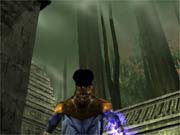
The environments we were able to see were very diverse, ranging from vast indoor temples of inhuman scale to sprawling swamps teeming with all manner of natural life. Visually, everything was simply stunning. Indoor environments were brought to life by superb color and vivid, detailed textures, and the architecture was eclectic and inspired. While many of the areas weren't populated, simply moving through them was exhilarating, as they made use of all of Raziel's abilities--many opportunities existed for wall-crawling, gliding, and tried-and-true platform jumping. "The power of the PS2 has allowed us to do many things environment-wise that we wanted to do in Soul Reaver, but were too constrained by the hardware," Bennet said. "For example, we now only use fogging for atmosphere and ambience, whereas on the PlayStation we fogged mostly to help with the frame rate. The PS2 also allows us to have bigger vistas and more expansive indoor and outdoor environments. Overall, we've been able to create much more detailed, architecturally realistic environments than we could have previously."
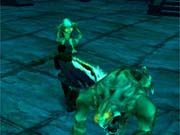
Players of the original Soul Reaver will fondly remember the neat geographical deformation that would occur when Raziel shifted from the material plane to the spectral. Allowed to shift to the spectral world at will, players were able to explore the world of Nosgoth from two distinct perspectives, with an accompanying visual transformation. The game would be directly impacted by the transformation--uncrossable chasms would become manageable, towering platforms would shrink to reachable sizes, and deadly water would turn to harmless mist. An aesthetic change would likewise occur. The world would turn a washed-out bluish green and surfaces would expand or contract. Soul Reaver 2 will turn this all up a notch. "On the PS2, we've added texture-morphing to the engine, which enables us, in certain cases, to reveal different textures in each plane of existence," Bennet revealed. "A mural on a wall might morph when the player moves to the spectral plane, providing extra clues to the story or a current puzzle. This is often just used for aesthetic effect--as in outdoor areas, where the sky and horizon morph into a twisted version of their material counterparts."
Sadly, we weren't able to experience any of this for ourselves--the spectral versions of the environments we got to see weren't included in the build. The dichotomy between the spectral and material realms will be more pronounced in this sequel, according to Crystal Dynamics, and it will factor into the game's puzzles more than in its predecessor.
Machinations
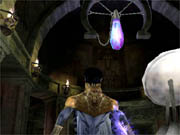
The original Soul Reaver was quite heavy on puzzles, without a doubt. Similarly doubtless is the fact that Soul Reaver's puzzles are a touchy subject among the game's fans. It all came down to blocks, and the fact that there were too many of them--even Bennet agreed: "The redundant block-based puzzles were one of our major gripes, too!" While one could argue that the designers did as much as they could to make the block puzzles as interesting as possible, it's hard to deny that, after a full game's worth of them, the activity became a bit old. Fans will find much relief in the fact that Soul Reaver 2 will feature a thoroughly redesigned puzzle engine. The enigmas players will encounter will be much more varied and logical and less arbitrary, as Bennet explained: "When we started Soul Reaver 2, we set out to create a richer puzzle system, based primarily on the mechanics earned with the elemental Reavers and an expanded use of puzzle objects. One of the most useful enhancements has been the establishment of the lock and key puzzle system, which allows the designers to implement unique and context-appropriate object interactions. This may be as simple (and literal) as Raziel acquiring a key object and carrying it to lock object in the level in order to progress. Or it can be more complex--Raziel may need to kill an enemy bearing a reflective shield in order to place the disk in a receptacle and bounce light onto a crystal in a darkened room."
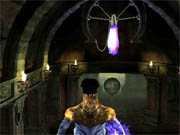
We actually got to see something similar to the above example in action. Taking place in one of the large indoor environments, the puzzle in question spanned two large chambers and required the use of various environmental objects to complete. Essentially, we had to reflect light from one room to another so we could use it in the second room to create a shadow bridge that would allow us to traverse a wide gap. This involved pivoting a pillar with an attached reflector in the first room so the light bounced into the next. We followed the beam into the next room, and once there, we examined the walls and saw a bas-relief depicting a pillar casting a long shadow. Seeing a similar pillar on the edge of the chasm, we deduced that it had to be moved into a position where it would obstruct the light. Once we moved the pillar, a shadow bridge indeed materialized, and we were able to safely cross the chasm. Each of the puzzle's steps were soundly designed--its effect on the gameworld was logical, suitable clues for its solving were provided, and it involved absolutely no blocks.
"In most game engines, this would require a great deal of time for a programmer to implement on a one-off basis (this desire to avoid hard-coding events is partly what led to the proliferation of blocks in Soul Reaver)," Bennet explained. "With our new system, designers, animators, and artists can work independently to implement complex puzzles without a programmer's intervention, thus opening up the palette of puzzles that we now have in Soul Reaver 2." We sincerely hope that all of Soul Reaver 2's puzzles are similarly well conceived. Given the tools in place, it's certainly likely.
A Reaver of Bodies and Souls

Given Nosgoth's brutal nature, it's safe to assume that Raziel will get into a fair number of scrapes, with beings both living and undead. While combat in the original Soul Reaver was certainly engaging, one often got the feeling that it was altogether possible avoid most enemies entirely. There certainly were many situations where combat was inevitable, to be sure--who can forget the tight, claustrophobic chambers littered with vampires who would continually respawn as you frantically pieced together a puzzle? But enemies encountered on the field, for the most part, were unfortunately largely avoidable--unfortunate because the game's combat system was both dynamic and twistedly satisfying.
Rectifying this, needless to say, has been at the top of the developer's list. "Our main focus this time has been to force combat and then also to use the power of the PS2 to make it more interesting and challenging for the player," Bennet revealed. "We're forcing the player to engage in more combat in a variety of ways. Firstly we're going to have more situations where the player has to defeat the enemies in an area before a door or other obstacle can be cleared so Raziel can progress. The programmers, animators, and designers have also worked closely together so we can give enemies puzzle-solving pieces that Raziel has to acquire in combat in order to solve a puzzle. This can be as simple as taking a 'key' object from a guard, or it can be more complex--such as taking a unique weapon or shield from one enemy that will be useful to pass a more powerful enemy later on." Even if they aren't holding some puzzle-specific item, however, many enemies won't be easy to dodge. "We're also overcoming the jump over/run around problem by making the enemies smarter," Bennet explained. "There are various enemy types in Soul Reaver 2 that have the ability to snatch Raziel out of the air or otherwise impede his passage through the level--by pursuing him rapidly and relentlessly, for example."
"This time we've added the ability to dismember and decapitate enemies, amongst other things."- Andrew Bennet on Soul Reaver 2's combat system
This is certainly good news for players eager to make use of Raziel's wicked set of abilities. Certain core mechanics have changed quite a bit from the original game, however. Most notable is the fact that the Soul Reaver will "heat up," so to speak, after prolonged use. A meter to gauge this exists alongside the life meter--once it's full, Raziel will begin to lose life. This will result, the developer hopes, in shorter, more focused battles. It'll also add a significant amount of strategy to the proceedings.
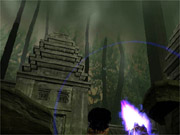
Also notable is the fact that the Soul Reaver is now capable of firing projectiles. When performing this, the camera shifts to a closer over-the-shoulder perspective and an aiming-reticule appears onscreen, allowing you to aim your shot. The actual projectiles take the form of the Reaver's essence and bear the characteristics of its current elemental composition. The dark reaver, for instance, will shoot dark, shadowy bolts, while the fire reaver will emit small bursts of flame. As previously stated, the Reaver's current elemental makeup will also come into play in hand-to-hand combat. Some enemies will be less susceptible--or totally immune--to certain types of attacks. Conversely, some will have definite weaknesses. "This requires the player to 'learn' the different enemies' vulnerabilities and make sure they're properly armed before engaging in combat," Bennet explained.
Combat in the final product should prove brutally satisfying for all involved. "Overall, we've made the combat system more intuitive and responsive, and we've expanded Raziel's moves to include more blocking and evasive maneuvers and a more varied suite of attacks, including a greater variety of finishing moves," Bennet revealed. "Last time, we had such visual treats as setting enemies on fire and impaling them. This time, we've added the ability to dismember and decapitate enemies, among other things."
Darkest Works
The development of Soul Reaver 2 has definitely been arduous, but these last few months are definitely the final stretch in the game's cycle. From what we've seen, most of the essentials are in place. The game we saw last week was marvelously playable and aesthetically grand, so we can only assume that these final months will be used to ensure that the product will be tight, polished, and seamless.
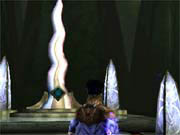
Crystal Dynamics has a rather ambitious design philosophy, as it doesn't focus as much on designing single games as it does on weaving an entire mythology. Given the scope of the studio's projects, it's hard to imagine how it manages to contain its ideas in the form of a single game, produced in the span of a standard product cycle. "There are always trade-offs which have to be made when any product is created, whether due to schedule, budgetary, or technical constraints," Bennet admitted. "There are many, many features originally conceived that don't make the final cut. Most of the time, these features are eliminated or slimmed down, either because they don't work as originally anticipated or because completing them as originally specified would mean that large parts of the rest of the game won't be properly polished. These kind of edits are always difficult and regrettable, but they are also an inevitable part of the process."
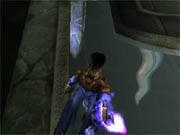
Some compromises have indeed been made. It's no secret that Soul Reaver 2 began its cycle in concurrent development for both the PlayStation 2 and Dreamcast platforms. When the latter version was cancelled, fans of both Sega and the Legacy of Kain series were very distraught. According to Bennet, so was the development team: "We understand that Dreamcast fans of Soul Reaver were looking forward to Soul Reaver 2. The team was also disappointed--we'd been able to really push the limits of the DC. Unfortunately, when the manufacturer of a console stops manufacturing it, it signals a large decrease in the possible sales of games for that console. It's therefore regrettably very much outside of our control." So it goes. On the bright side, it can be argued that single-platform development will ultimately help the game. "It's always easier to make a game for one platform at a time," Bennet said. "You don't have to keep constantly checking to make sure that everything works on both all the time. And, of course, you can also make sure that the game really pushes the platform when you only have one to worry about."
Fans of the Legacy of Kain series seem more than willing to wait the allotted time for the further installments in the series, regardless of what platform they'll eventually grace. And with Blood Omen 2 tangibly on the horizon, it seems as if the wait for the next chapter will perhaps not be so long. In any case, Soul Reaver 2 has us very excited, and we can't wait to get out hands on the next build of the game at this year's E3. Keep your eyes on this space till then. Legacy of Kain: Soul Reaver 2 is due to ship this fall.
Got a news tip or want to contact us directly? Email news@gamespot.com
Join the conversation